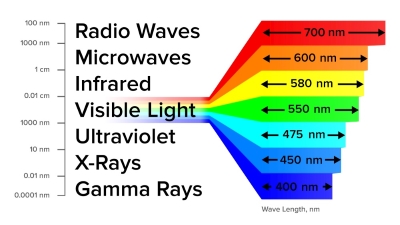Infrared Optics used to be a rarified technology. Therefore, it was seldom seen, used, or understood by everyday consumers.
Now, however, we increasingly find IR in the course of our ordinary lives. Manufacturers use Infrared Optics in such common instruments as thermometers and thermal cameras.
Thus E.R. Precision Optics thought it would be fascinating to reveal some of the details behind this uncommon technology. Certainly, it is becoming more and more common in our everyday lives. For example, as you go about daily life, you will likely encounter infrared optics in hospitals, malls, and even airports. Therefore, we bring you the story of Infrared Optics in a two-blog series about this fascinating technology.
Infrared Optics: The Backstory

Have You Ever Wondered How Your Remote Control Works? Infrared Light is Its Secret.
So, you might ask, how do devices like infrared thermometers and cameras work? So, let’s break down the basics of this technology into 3 basic, important points.
1. In the first place, understand that “These devices measure the surface temperature of an object…” They do this by “detecting emitted or reflected IR radiation from its surface.”
2. Secondly, if follows that “The hotter the object, the higher the amount of IR radiation it emits.”
3. Finally, “Since the temperature of an object is a measure of its heat, IR radiation can be used for contactless temperature measurement.
A Practical Application for Infrared Optics
And, obviously, that’s how the nurse at your local clinic can take your temperature by pointing a handpiece at you. She doesn’t need to touch your mouth or forehead. (And yes, given the days of the Pandemic, this application of Infrared Optics technology recently gained popularity very quickly.)
More Gifts from the Infrared Optics Technology

IR: Definitely Essential in Driverless Cars. Moreover, IR Gives Sight to an Otherwise Blind Auto.
But the story of Infrared Optics goes far beyond thermometers. In fact, experts say, “The IR region is a particularly important band of the electromagnetic spectrum…”
Why? Because it has a large number of applications. And on a deeper level, other phenomena such as molecular vibrations happen in this part of the spectrum. Now, check out this list of everyday uses brought to you by Infrared Optics and technology:
1. It’s the magic inside your TV remote.
2. In the hospital, the common pulse oximeters work with it.
3. Self-driving cars would be blind without their infrared optics.
Basically, you can find new Infrared technology applications in most industries today.
- See it in the healthcare, industry.
- Watch it control quality in our food safety avenues.
- As you might have guessed from our previous blogs, Infrared Optics has become indispensable “in communication, space and astronomy, and defense.” And, coincidentally, these are areas where our work at ER Precision Optics excels.
Beyond the Basics: Meet the Materials of Infrared Technology
We are seeing innovations in this field because science and technology are constantly developing IR sources and materials. Let’s take a look at some of these IR (Infrared) materials and see how they are developed into new uses.
Taking a Deep Dive into the Infrared Spectrum

Infrared Light: Beyond Visible Light.
In brief, any science book will explain that “The IR spectrum is situated between the visible and microwave regions of the electromagnetic spectrum.”
You might want to know that in terms of wavelength, it goes from 0.75 microns to 12 microns. Additionally, the symbol for micron is μ.
From there, we divide it into 4 classifications:
1. Infrared (NIR).
2. Short Wave Infrared (SWIR).
3. Mid Wave Infrared (MWIR).
4. And Long Wave Infrared (LWIR.)
First: The Electromagnetic Spectrum –Meet The Infrared Band Called NIR
This band is termed the “Near-Infrared.” —This ranges from 0.75μ to 1μ. We abbreviate it the NIR spectral band.
This simple band of light gives us the capability for testing food. It has led to both biomedical and agricultural instruments. Additionally, of course, we must not forget those very important remote controls.
A Lifesaving Example of NIR
For example, we use NIR technology in pulse oximeters. They perform the valuable function of testing oxygen saturation in the blood. To do this, the instrument uses “a combination of red (700nm) and IR LEDs (900nm) to determine the optical absorption of oxy- and deoxyhemoglobin.”
A Transportation Example for NIR Technology
Self-driving cars use this technology through LIDAR. That’s how they map their environment. “LIDAR infrared optics typically operate at wavelengths of 905nm or 940nm.”
Likewise, neither night vision goggles nor image intensifier tubes could work without the NIR band. This also puts the remote capability in your control devices. They use 940nm LEDs for communicating with devices you want to control.
NIR Detector Materials
As you might already know, the most common NIR optical material used in the above examples is Silicon. And most importantly, that is an element much cherished and respected here at ER Precision Optical.
Among its attributes, Silicon has responsivity from 400nm to 1100nm. This makes it an ideal material for applications in NIR detection.
Meet Other NIR Transparent Materials

Can You See In The Dark? Your Security System Can, Courteousy of Infrared Optics.
Several of the same infrared materials used in the UV and visible part of the electromagnetic spectrum work quite well in the NIR spectrum. For example, manufacturers have discovered “Glasses and ceramics such as BK7, UV and IR fused silica, quartz, and sapphire are suitable for optical windows, lenses, and other components…” This is because they provide great transmission in the FLIR range.
Terrific Take-Away and an Invitation to Part Two
In Part Two of “Infrared Optics Meet Everyday Life,” we will bring you some of the applications and materials behind the rest of the Infrared Classifications. They are, as mentioned above, Short Wave Infrared,(SWIR), Mid Wave Infrared (MWIR), and Long Wave Infrared (LWIR.)
And with Infrared Optics, each level brings its own unique gifts, too numerous for just one blog. Stay tuned next week for more about Infrared Optics, and how they are constantly changing your life.


